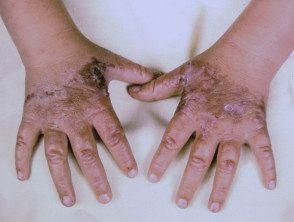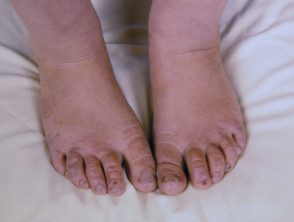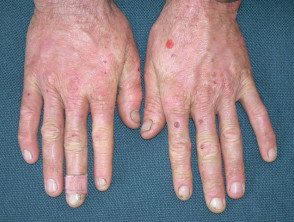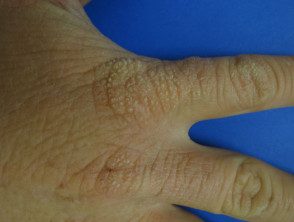What is erythropoietic protoporphyria?
Erythropoietic protoporphyria (PPE) is one of a group of genetic diseases called porphyrias. PPE is due to an inherited deficiency of enzyme Ferrokelatase The reduced activity of this enzyme causes an accumulation of the chemical protoporphyrin in the skin; Resulting in photosensitivity The skin damages the skin. Abnormally high levels of protoporphyrin can rarely cause liver disease.
Who gets erythropoietic protoporphyria?
Predominance PPE in Europe varies from 1 in 55,000 to 1 in 150,000 of the population. It affects men and women equally, and people of all races can have PPE.
PPE is believed to be due to a loss of compound function mutation at gene coding for ferrokelatase (FECH; 612386) found in chromosome 18q21. Typically, there is a mutation in one gene, as well as in one second, of low expression allele. Both men and women are equally affected. Rarely, there is a gain in the ALA synthase (ALAS) -2 function mutation (dominant inheritance linked to the X chromosome). Therefore, inheritance can be autosomal recessive or autosomal dominant with incomplete penetrance (96% from patients in the UK).
Myelodysplasia is a neoplastic proliferation of bone marrow cells and causes chromosomal instability. Acquired PPE was described in an older woman with myelodysplasia and was found to be due to knockout loss of chromosome 18.
What are the clinical characteristics of erythropoietic protoporphyria?
Cutaneous symptoms and signs of PPE
The first symptoms usually appear in infancy or early childhood and present as an uncomfortable or painful burning sensation of the skin after exposure to the sun. It occurs most often on the upper part of the hands and feet, face, and ears. In most cases, the visible changes are slight. The affected skin may become red, swollen, and blistered. Later there are pitted scars and sometimes thick, thick skin, particularly on the cheeks, nose, and knuckles of the hands.
Mild PPE causes visible swelling and mild discomfort after sun exposure. It affects the face and back of the hands and feet.
Erythropoietic protoporphyria

Erythropoietic protoporphyria

Erythropoietic protoporphyria

Erythropoietic protoporphyria

Erythropoietic protoporphyria

Erythropoietic protoporphyria

Erythropoietic protoporphyria

Erythropoietic protoporphyria

Erythropoietic protoporphyria
Liver disease in PPE
People with EPP-induced liver disease often have mild changes in liver blood tests. Around 10% develops more severe liver disease, presenting with discomfort, pain under the ribs on the right, jaundice and increased photosensitivity.
Gallstones are common in patients with PPE.
How is erythropoietic protoporphyria diagnosed?
The diagnosis of PPE is often made during childhood.
- It can be seen that the patient's red blood cells emit ultraviolet fluorescence microscopy.
- The diagnosis of PPE is confirmed by finding increased levels of protoporphyrin in the blood and reduced activity of the enzyme ferrokelatase. The severity of the biochemical findings is variable.
- Genetic testing is available at some centers.
- A biopsy It can also be useful, since EPP has some features in histopathology.
The following monitoring tests are often done from time to time.
- Complete blood count to assess anemia
- Iron tests: iron deficiency may be present and must be monitored
- Liver function tests
-
Vitamin D levels
What treatment is available for erythropoietic protoporphyria?
Lifetime photosensitivity is the main problem for PPE without complications from liver disease.
- Avoid unnecessary exposure to sunlight and wear protective clothing and wide-brimmed hats. Consider tinting windows.
- Other light sources can also cause symptoms, including fluorescent and halogen lights.
- Protect the skin from exposure to operation lamps during a surgical procedure.
-
Sunscreens can be helpful, especially formulations containing zinc oxide or titanium dioxide that reflect visible light.
-
Vitamin D supplementation is appropriate in patients who strictly avoid exposure to sunlight.
Treatment trials for PPE have been difficult to assess. Effective treatment should reduce pain and increase time outdoors without pain.
-
Afamelanotide, an α-melanocyte stimulating hormone given by subcutaneous implantation has been reported to provide clinical effectiveness and safety in PPE. It is approved in exceptional circumstances by the European Medicines Agency for the treatment of PPE (October 2014).
-
Narrowband UVB phototherapy increases melanin content and induces thickening of the skin, so it can reduce sensitivity to the sun in some patients.
Individual patients can benefit from oral antioxidants like beta-carotene and N-acetylcysteine. They should avoid iron supplementation (unless it is severely deficient in iron), as iron can increase photosensitivity in PPE.
- Cholestyramine reduces hepatic protoporphyrin content but does not reduce photosensitivity.
- PPE patients who also have liver disease require specialized medical treatment and possibly liver transplant.
Another more serious condition, congenital Erythropoietic porphyria is now curable by stem cell transfusion, paving hope for the future, but a cure for PPE is not yet available.
